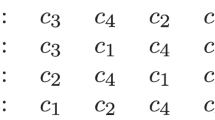Abstract
In this paper, we discuss the problem of stable matching with hybrid preferences among the three agent sets U, \(V_1\) and \(V_2\). We consider two hybrid preferences. One is that the agents of set U has a strict preference to the agents of set \(V_1 \times V_2\), and the agents of set \(V_1\) and \(V_2\) have a strict preference to the agents of set U respectively. The other is that the agents of set U has a strict preference to the agents of set \(V_1 \times V_2\), and the agents of set \(V_1 \times V_2\) has a strict preference to the agents of set U.
Similar content being viewed by others
References
Aldershof B, Carducci OM (1996) Stable matching with couples. Discrete Appl Math 68:203–207
Bir P, McDermid E (2010) Three-sided stable matchings with cyclic preferences. Algorithmica 58:5–18
Cechlrova K, Fleinerbc T, Manloved DF, McBrided I (2016) Stable matchings of teachers to schools. Theor Comput Sci 653:15–25
Chakraborty A, Citanna A, Ostrovsky M (2015) Subquadratic algorithms for succinct stable matching. Rev Econ Des 19:3–24
Chakraborty A, Citanna A, Ostrovsky M (2016) Almost-stable matchings in the hospitals/residents problem with couples. https://doi.org/10.1007/s10058-014-0156-3
Cseha A, Manloveb DF (2016) Stable marriage and roommates problems with restricted edges: complexity and approximability. Discrete Optim 20:62–89
Gale D, Shapley LS (1962) College admissions and the stability of marriage. Am Math Mon 69:9–15
Gelain M, Pini MS, Rossi F, Venable KB, Walsh T (2010) Local search for stable marriage problems with ties and incomplete lists. In: Zhang B-T, Orgun MA (eds) PRICAI 2010, LNAI 6230. pp 64–75
Huang C-C (2010) Circular stable matching and 3-way kidney transplant. Algorithmica 58:137–150
Kamiyama, N. (2015): Stable matchings with ties, master preference lists, and matroid constraints. In: Hoefer M (ed) SAGT 2015, LNCS 9347. pp 3–14
Lazarova E, Borm P, Estvez-Fernndez Arantza (2016) Transfers and exchange-stability in two-sided matching problems. Theory Decis 81:53–71
Li J (2013) A note on Roth’s consensus property of many-to-one matching. Math Oper Res 38(2):389–392
Manlove DF (2015) The hospitals/residents problem. In: Encyclopedia of algorithms. https://doi.org/10.1007/978-3-642-27848-8_180-2
McDermid EJ, Manlove DF (2010) Keeping partners together: algorithmic results for the hospitals/residents problem with couples. J Comb Optim 19(3):279–303
Ng C, Hirschberg DS (1991) Three-dimensional stable matching problems. SIAM J Discrete Math 4(2):245–252
Acknowledgements
This research is supported by the Shanghai Science Committee of China under Grant Number 17495810503, and the Applied Mathematical Subject of SSPU under Grant Number XXKPY1604. We would like to express our heartfelt thanks.
Author information
Authors and Affiliations
Corresponding author
Rights and permissions
About this article
Cite this article
Zhang, F., Li, J., Fan, J. et al. Three-dimensional stable matching with hybrid preferences. J Comb Optim 37, 330–336 (2019). https://doi.org/10.1007/s10878-017-0231-0
Published:
Issue Date:
DOI: https://doi.org/10.1007/s10878-017-0231-0



